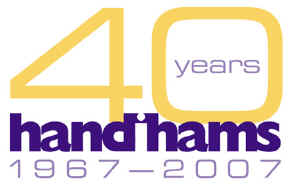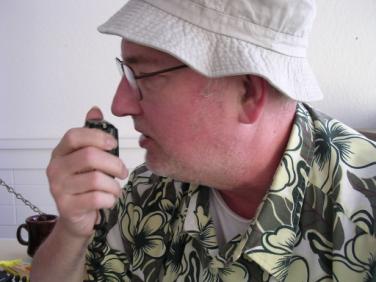 In this issue you will find:
In this issue you will find:
- Monopolizing the airwaves
- At headquarters: Camp dates set for 2008, equipment request submitted
- Avery's QTH: A teaching moment
- Space Shuttle audio
- WWV rumor is good for a laugh
- Free screenreader
Greetings from my work-at-home office and ham shack!
Pictures: Cartoon graphic of sun and photo of Dennis, K0CCR, getting on the air.
 C'mon, sun! We are certainly stuck at low ebb as far as solar activity goes. I'm starting to think back to the last solar cycle's upturn, when the Icom company featured "Here comes the sun" ads. No one is ready to proclaim that the current cycle is ready to start producing more sunspots. ARRL reported last week that the sun was blank, and the SOHO sun gadget I have in my Windows Desktop Sidebar tells the same sad story this week. The past weekend I listened a bit on 20 meters and had to check to see if the coax was even connected, but it was just bad band conditions.
C'mon, sun! We are certainly stuck at low ebb as far as solar activity goes. I'm starting to think back to the last solar cycle's upturn, when the Icom company featured "Here comes the sun" ads. No one is ready to proclaim that the current cycle is ready to start producing more sunspots. ARRL reported last week that the sun was blank, and the SOHO sun gadget I have in my Windows Desktop Sidebar tells the same sad story this week. The past weekend I listened a bit on 20 meters and had to check to see if the coax was even connected, but it was just bad band conditions.
So what to do? Fortunately, with winter coming on here in Minnesota, we are starting to see better band conditions on 75 and 40 meters. The summer sun drives the atmospheric conditions that produce thunderstorms, and with less daylight we have less thunderstorm static on the bands. Even at solar minimum, these two bands tend to be reliable spots to make reliable HF contacts.
But EchoLink and EchoLink-enabled repeaters as well as the reliable IRLP system have really come into their own as the sunspot cycle tanked. November 4 will mark the end of daylight saving time here in the United States, which means that we will be making some changes in the Handiham daily EchoLink net. I have heard a number of suggestions about net timing, and we have boiled our choices down to these:
1. Keep the net time exactly as it is, without following the change back to standard time. This would mean that the 11:00 CDT net, which is at 16:00 GMT, would stay at 16:00 GMT but would change to 10:00 A.M. United States Central Standard Time.
2. Change the net time relative to GMT, but keep it the same time relative to Minnesota time. Thus, the net would be at 11:00 A.M. Central Standard Time, but change to 17:00 GMT on November 5.
Your thoughts on this are needed soon, so that we can make a decision.
Now, with that out of the way, here is some related information:
In an email discussion, Jerry, N0VOE, got the following comment from a local Twin Cities repeater user:
"It seems like there is a Handiham net on every day -- sometimes twice a day -- on the air. Is there really a need for MORE nets? Can't the Handiham folks get on the air without a net and participate in our king of hobbies with general chatter without monopolizing the airwaves?"
Are Handiham nets "monopolizing the airwaves"?
I would suggest that the ham bands are in need of more activity, not less. I monitor a few wide-area repeaters and hear little or no activity all day long. Even drive time is usually quiet, thanks to the availability of cell phones. If a Handiham EchoLink-enabled net is on the air an average of, say, 40 minutes a day, that amounts to 280 minutes per week. A week has 10,080 minutes, so if my math is correct, the Handiham nets are on less than 3% of the time. Granted, no one would consider the wee hours overnight as "prime time" on the repeater systems, but even so the daytime net usage can hardly be considered to be "monopolizing the airwaves". While some of the repeaters are linked in the Twin Cities coverage area (which makes the Handiham net appear on multiple systems at times), there are still so many underutilized systems out there begging for someone to throw out a callsign that it is virtually always possible to find an idle repeater.
 A ham who has not been active through several solar cycles might not be aware of how solar minima can drive ham radio technology and social interaction. At maxima, HF conditions are great and operators spend a lot of time working DX and enjoying reliable HF contacts, be they nets, contests, DX, or plain old QSO's. At minima, hams get creative and start building systems and gear that are suited to the diminished HF conditions. This is what drove the 2 meter repeater system into the mainstream of amateur radio at a time when manufacturers were selling HF rigs that worked only on the lower HF bands. At the current solar minimum it is VoIP that is now becoming mainstream. The technology follows the band conditions to allow hams to stay connected with new technologies and to maintain the social connections they have built up when HF conditions were better. Thus, VoIP has become a mainstay of really good, vibrant, healthy repeater systems.
A ham who has not been active through several solar cycles might not be aware of how solar minima can drive ham radio technology and social interaction. At maxima, HF conditions are great and operators spend a lot of time working DX and enjoying reliable HF contacts, be they nets, contests, DX, or plain old QSO's. At minima, hams get creative and start building systems and gear that are suited to the diminished HF conditions. This is what drove the 2 meter repeater system into the mainstream of amateur radio at a time when manufacturers were selling HF rigs that worked only on the lower HF bands. At the current solar minimum it is VoIP that is now becoming mainstream. The technology follows the band conditions to allow hams to stay connected with new technologies and to maintain the social connections they have built up when HF conditions were better. Thus, VoIP has become a mainstay of really good, vibrant, healthy repeater systems.
EchoLink operation is also more inclusive, allowing Handiham members of any license class to interact over large distances. An HF net, to be as inclusive, would have to be on an HF phone frequency open to Technician class operators, which (of course) means 10 meters. Good luck with that at solar minimum!
So EchoLink can be an excellent way to bring new hams up to speed on operating skills at any time in the solar cycle. It is also ideal, because of its reliability, as a platform for social interaction among friends on the air. It is certainly better to use the repeater infrastructure than to let it sit idle. Unused spectrum is likely to be ripe for the plucking by commercial interests.
The way I look at it, the Handihams are doing their part. Now, how about some other users getting on the air and making use of that other 97% of the air time?
Patrick Tice
wa0tda@arrl.net
Handiham Manager